Jeli Post-Incident Reviews and Postmortems
Document and learn from past major incident responses
Jeli Post-Incident Reviews are a structured evaluation process conducted after an incident or crisis to analyze what happened, why, and how to prevent it from happening again. It is a valuable tool for organizations to learn from mistakes, improve response procedures, and enhance overall resilience in the face of future challenges.
Postmortems are reports that allow users to learn from major incidents by providing a summary of events, how the response was handled, and what resolution steps were taken. Postmortems curate a timeline of activity in PagerDuty and Slack, which teams can analyze to determine follow-up actions for similar situations in the future help prevent them in the future.
Jeli Post-Incident Reviews
Users on Enterprise Incident Management or Customer Service Operations pricing plans have the option to create a post-incident review in Jeli.
Availability
Jeli is available to customers with a standalone Jeli plan, or if they are on the Enterprise Incident Management or Enterprise Customer Service Ops plans. For customers who have Jeli as part of their pricing plan, all users (regardless of user role) will have access to Jeli. Please contact our Sales Team to upgrade to an account plan with Jeli.
At this time, Jeli is not available for accounts in the EU service region (i.e.,
https://subdomain.eu.pagerduty.com).
Configure Jeli
Before you can create Post-Incident Reviews, you'll need to enable them in your account. Please read Enable Post-Incident Reviews for more information.
Create a Jeli Post-Incident Review
- You can create a Jeli Opportunity from any resolved PagerDuty incident. On a resolved incident, click Jeli Post Incident Review.
- Carefully review the Create a Jeli Post Incident Review prompt and click Accept & Continue to Jeli.
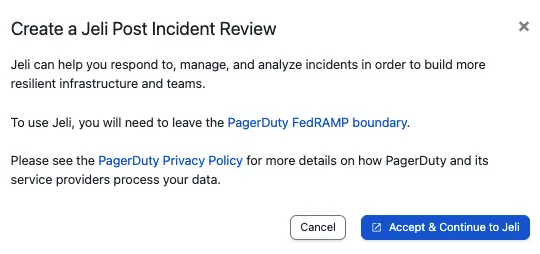
Create a Jeli Post-Incident Review
- When prompted, sign in to Jeli using the option Continue with PagerDuty.
- In the Jeli Opportunity, you can review all events from your PagerDuty timeline by clicking Narrative. For more information, please read Opportunities.
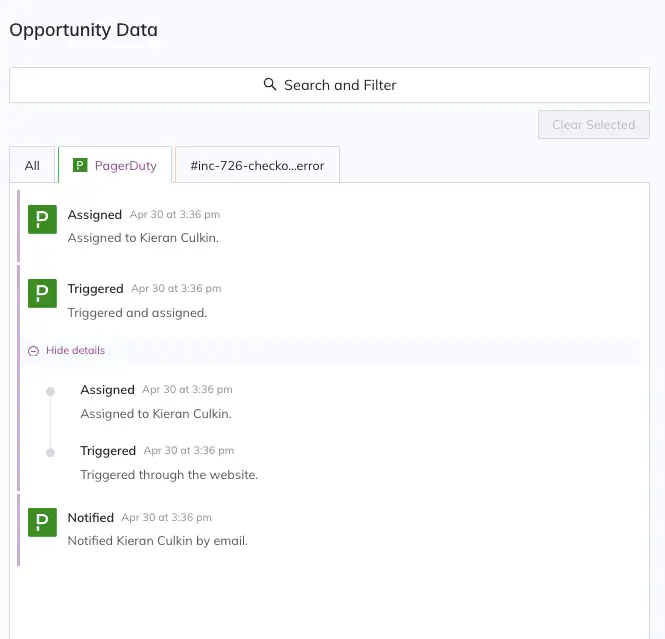
Jeli Opportunity data
Create a Postmortem
Pricing Plan
The Postmortems feature is available for accounts on our Business, Enterprise for Incident Management and Digital Operations (Legacy) plans.
Postmortems End-of-Life
Postmortems will be removed from the product and become unavailable on Jan 30, 2026.
Required User Permissions
Observers, Limited Users, Users, Admins and the Account Owner (or their respective Advanced Permissions base roles) can create, edit and delete postmortems.
- Navigate to Incidents Postmortems catalog and click New Report, or click New Postmortem Report on a resolved incident.
-
- If you created a new postmortem from the overview page: Enter a Report Name and Owner of Review Process. You may optionally enter an Impact Start Time and Impact End Time. Keep in mind that, although multiple people may have been involved in the incident’s response, a postmortem can only have a single owner. Click Create Report to continue.
- If you created a new postmortem from a resolved incident: Your report details will be auto-populated and you will be assigned as the Owner of Review Process. You can optionally edit these details as needed. Click Create Report to continue.
- Data Sources: This section allows you to build a timeline of incident log entries and Slack messages related to the incident.
- PagerDuty: To link incidents to this postmortem, either Select incident between impact start and end times from the dropdown, or Find by incident number by entering incident numbers (one at a time) and click Add This Incident.
- Slack: If you’d like to include discussions from public Slack channels, you can do so by clicking the Connect to Slack button. Once you’ve authorized PagerDuty to access your Slack account, you will then be prompted to search and select Channels to include in your report. Click Save Data Sources to continue.
Slack Data Source
To include Slack content in a postmortem, a contributor must authorize PagerDuty to access Slack on their behalf, which will let that contributor see Slack content in the Available Data listing. Each PagerDuty user will need to authorize with Slack individually.
If your Slack user account does not have permissions to add apps to your team, you will need to first ask a Slack admin to go to Slack's App Directory and authorize the PagerDuty Postmortems app.
-
Analysis: This section allows you to summarize and reflect on the curated timeline, including incident root cause analysis and potential steps to prevent or mitigate future incidents. Fill in the following fields based on your analysis:
Field Description Overview Include a short sentence or two summarizing the contributing factors, timeline summary, and the impact; for example, "On the morning of August 14th, we suffered a 14 minute SEV-1 due to a runaway process on our primary database machine. This slowness caused roughly 3% of reports generated during this time to be completed out of SLA." What Happened Include a short description of what happened, usually based on the timeline. Resolution Include a description what solved the problem. If there was a temporary fix in place, describe that along with the long-term solution. Root Causes Include a description of any conditions that contributed to the issue. If there were any actions taken that exacerbated the issue, also include them here with the intention of learning from any mistakes made during the resolution process. Impact Be specific here. Include numbers such as customers affected, cost to business, etc. What Went Well? List anything you think we did well and want to call out. It's okay to not list anything. What Didn't Go So Well? List anything you think we didn't do very well. The intent is that we should follow up on all points here to improve our processes. Action Items Include action items such as:
(1) fixes required to prevent the issue in the future,
(2) preparedness tasks that could help mitigate a similar incident if it came up again,
(3) remaining postmortem steps, such as an internal follow-up email, updating the public status page, etc.Add Section If you would like to add a new section, you may do so here. Customized Postmortem Templates
The fields above are from the default Postmortem Template. Some fields may be subject to change based on how your postmortems have been customized.
Each analysis field may be edited with the following options by clicking on the right:
- Edit Section Title
- Move to Top
- Move Up
- Move Down
- Move to Bottom
- Delete Section
You may also add new sections by clicking Add Section.
-
Timeline: All Slack messages and incident log entries from the above data sources will be listed in the Available Data column on the left. The incident Trigger and Resolve log entries will be listed by default in the Included in Timeline column on the right.
- To add Slack messages or incident log entries to the timeline: Select the event and click , or click to the left of the event to move it from the left column to the right. You can add multiple items at once by holding the shift key and then pressing to move them to the timeline. You can also manually add freeform entries to your timeline by selecting New Timeline Entry. Any Slack entries that are moved from the Available Data listing into the postmortem's Timeline will be visible to anyone looking at the postmortem.
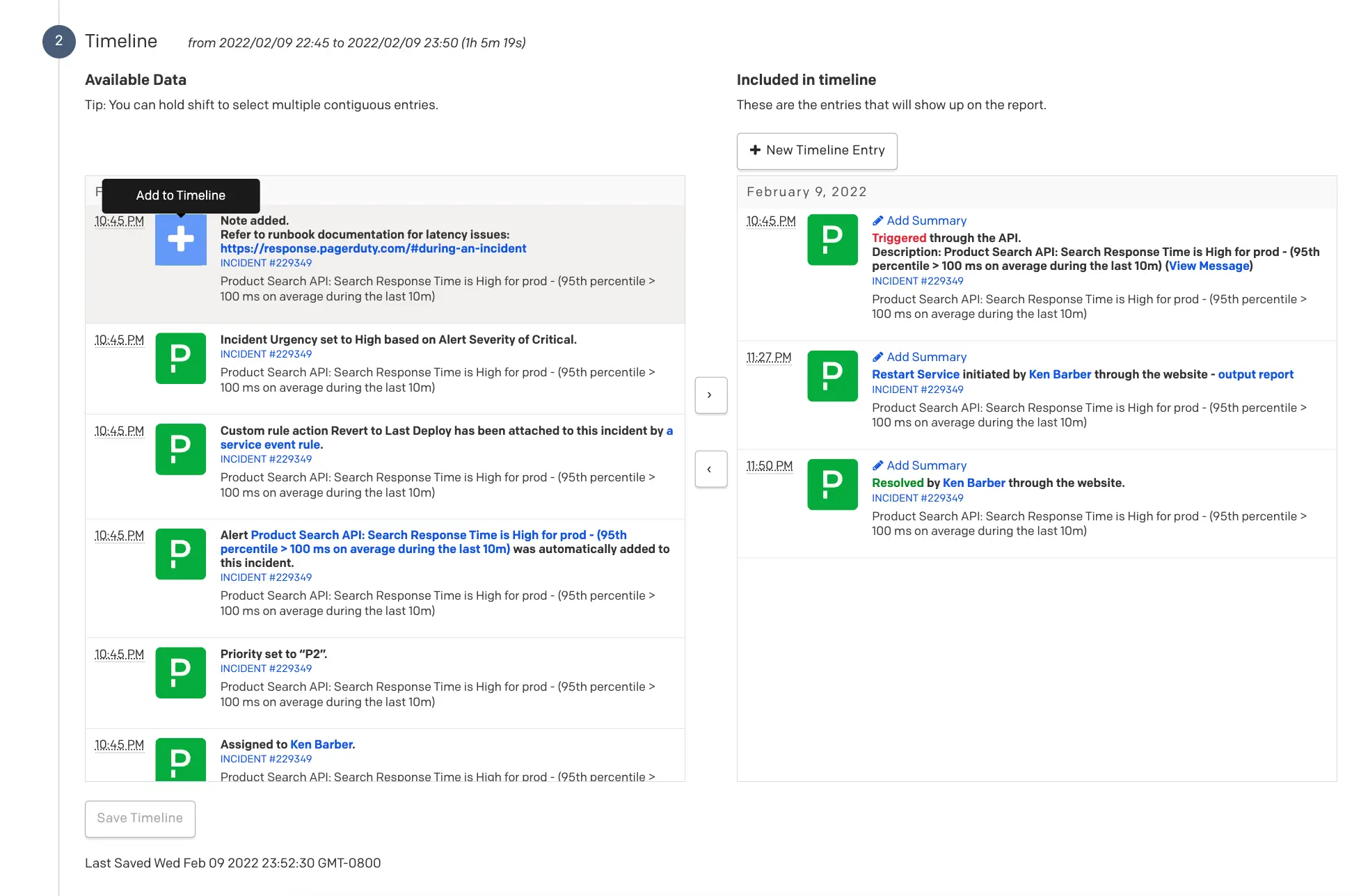
Add to timeline
- To remove an event from the timeline: Select the event and click , or click the to the left of the event to move it to the left column.
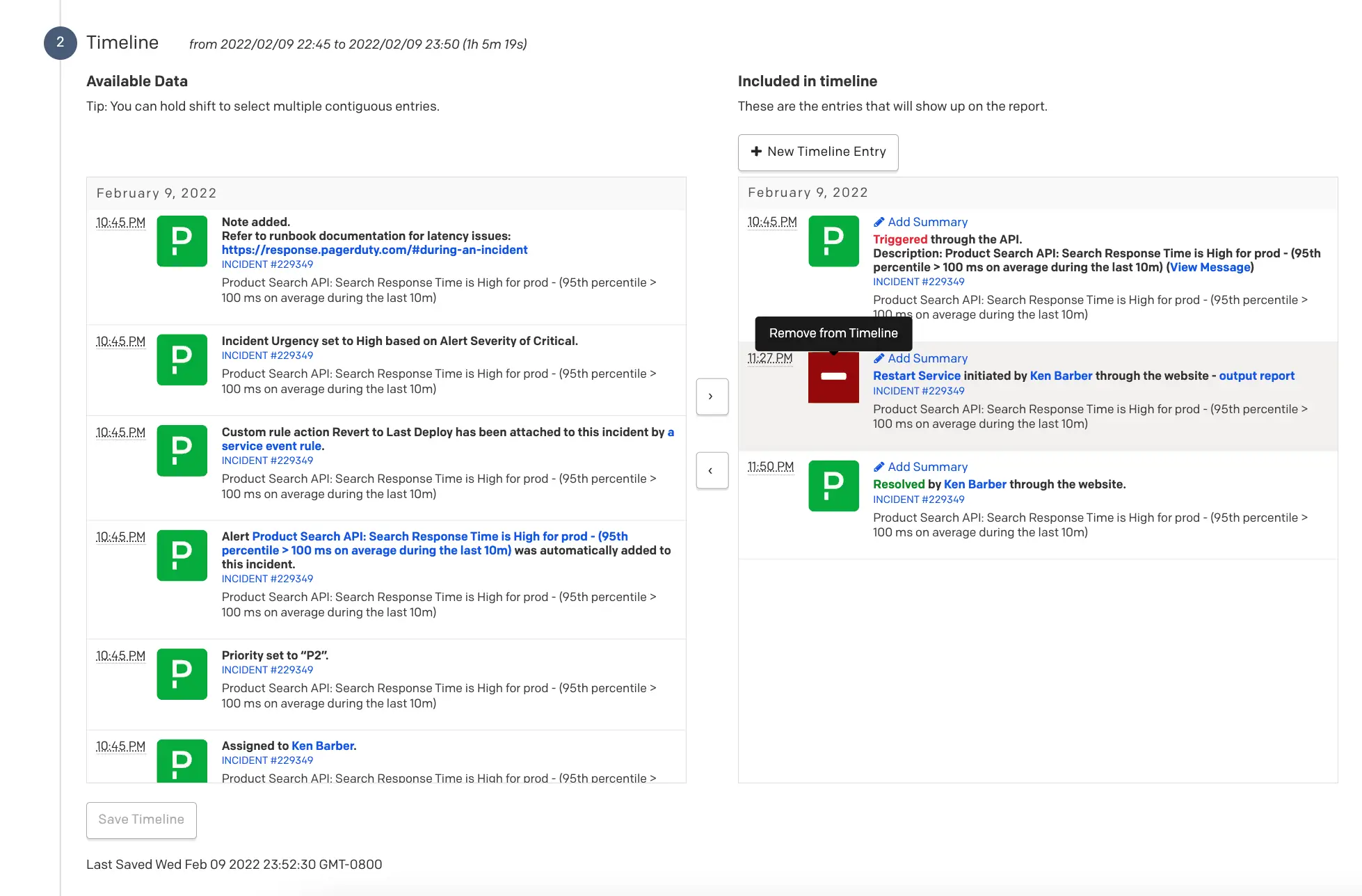
Remove from timeline
Click Save Timeline to proceed.
- Once you have completed and reviewed your report, click Save & View Report.
Edit a Postmortem
- Navigate to Incidents Postmortems and select Edit to the right of your desired postmortem, or you may select the postmortem’s Name and click Edit Report.
- Edit the postmortem's details as need and click Save & View Report.
Delete a Postmortem
- Navigate to Incidents Postmortems and select Delete to the right of the postmortem you'd like to delete, or you may select the postmortem’s Name and select Delete.
- A confirmation dialog will appear. Click Delete to delete your postmortem.
- Note: This action is not undoable.
Export a Postmortem
Once you have completed your postmortem report, you can export it as a PDF.
- Navigate to Incidents Postmortems and select your desired postmortem's Name.
- Click Save as PDF.

Save as PDF
Customize the Postmortem Template
The purpose of the postmortem process is to learn how to improve both system resiliency and the response process. As you learn new insights, you can customize your report and add or remove sections that apply to your team's specific use case.
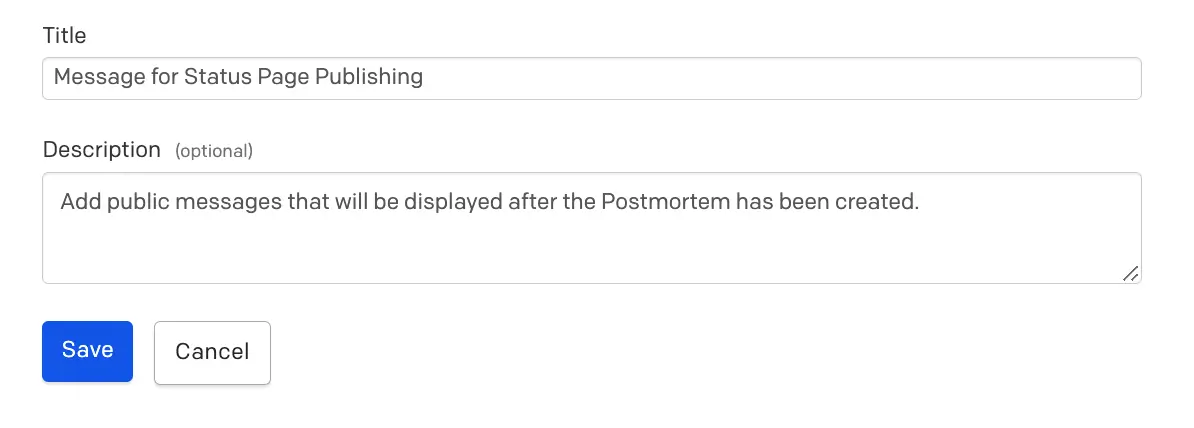
Customize the Postmortem template
- Navigate to Incidents Postmortems and select the Settings tab.
-
- To add a new section to your template: Scroll to the default New Section, click to the right and select Edit Section. You may then enter a new section Title and Description, and then click Save. To continue adding new sections, click the Add Section button at the bottom of the page.
- To edit existing sections: Click to the right and select Edit Section. Make any edits necessary and then click Save.
- To delete sections: Click to the right and select Delete. In the confirmation dialog that appears, click Yes, Delete Section.
Reset the Postmortem Template
You can reset your postmortem template to the default sections if needed.
Resetting Templates
Resetting your Report Template to its default will only affect future postmortem reports. This change will not affect existing postmortem reports.
- Navigate to Incidents Postmortems and select the Settings tab.
- Click the Reset Template button at the top of your Report Template. In the confirmation dialog that appears, click Yes, Reset Template.
FAQ
How can I change the Slack user associated with Postmortems?
To change the associated Slack user account, you'll have to revoke and replace the current Slack authentication only for the Postmortems feature.
Slack User Limitations
It is currently not possible to choose more than one Slack user specifically for the Postmortem feature.
- Within your Slack user account, access the My Authorizations section in the Slack API.
- Locate the PagerDuty Postmortems app under the Application & Scopes column.
- Click to the right of the PagerDuty Postmortems app to remove it only from your chosen Slack user account.

Remove PagerDuty Postmortems app
- While editing a postmortem in PagerDuty, click the Connect to Slack button under the Data Sources section to authenticate a different Slack user account to the Postmortems feature.
Is it possible to add images or documents to a postmortem?
It is possible to insert an external link or URL in any postmortem field which hosts the image or document externally. You can insert the link or URL into the section text, timeline entry summary, or in the description of a manual timeline entry within a postmortem. When the link or URL is clicked, then the image or document will open in a new tab. However, it is currently not possible to insert an image directly into a postmortem.
Updated 24 days ago
